Abstract
Leminorella is proposed as a new genus for the group of Enterobacteriaceae formerly known as Enteric Group 57. Strains of Leminorella gave positive tests for H2S production, acid production from L-arabinose and D-xylose, and tyrosine clearing; they were negative for indole production, Voges-Proskauer, urea hydrolysis, phenylalanine deaminase, motility, gelatin liquefaction, lysine and ornithine decarboxylases, arginine dihydrolase, growth in KCN, and acid production from adonitol, D-arabitol, cellobiose, erythritol, D-galactose, myo-inositol, lactose, maltose, D-mannitol, D-mannose, melibiose, alpha-CH3-glucoside, raffinose, L-rhamnose, salicin, D-sorbitol, sucrose, and trehalose. By DNA hybridization, strains of Leminorella were only 3 to 16% related to other Enterobacteriaceae and were divided into three groups. Leminorella grimontii is proposed as the type species for the genus and strain CDC 1944-81, ATCC 33999, is designated as the type strain. There were four strains of L. grimontii from stool specimens and two from urine specimens. L. richardii is proposed as the name for the second species (type strain, CDC 0978-82, ATCC 33998). All four L. richardii strains were from stool specimens. L. grimontii can be distinguished from L. richardii because it produces gas from glucose (100%) and acid from dulcitol (83%) and is methyl red positive (100%). One strain, CDC 3346-72, was more related to L. grimontii by DNA hybridization than to L. richardii, but the lower relatedness to both of these species indicated that it may be a third species. Biochemically it could not be distinguished from L. grimontii. All Leminorella strains were resistant (no zone of inhibition) to ampicillin, carbenicillin, and cephalothin. Some of the Leminorella strains were sent to us for Salmonella serotyping, and two reacted weakly in Salmonella antisera. The clinical significance of Leminorella is unknown.
Full text
PDF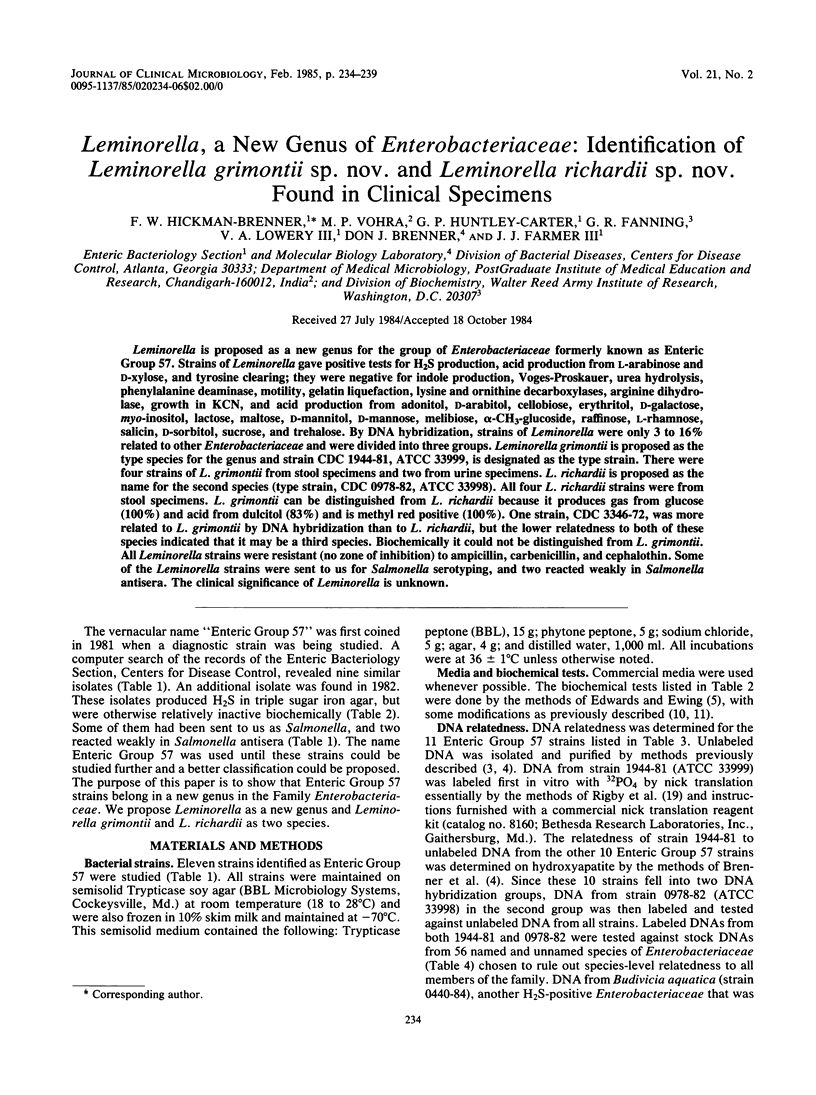
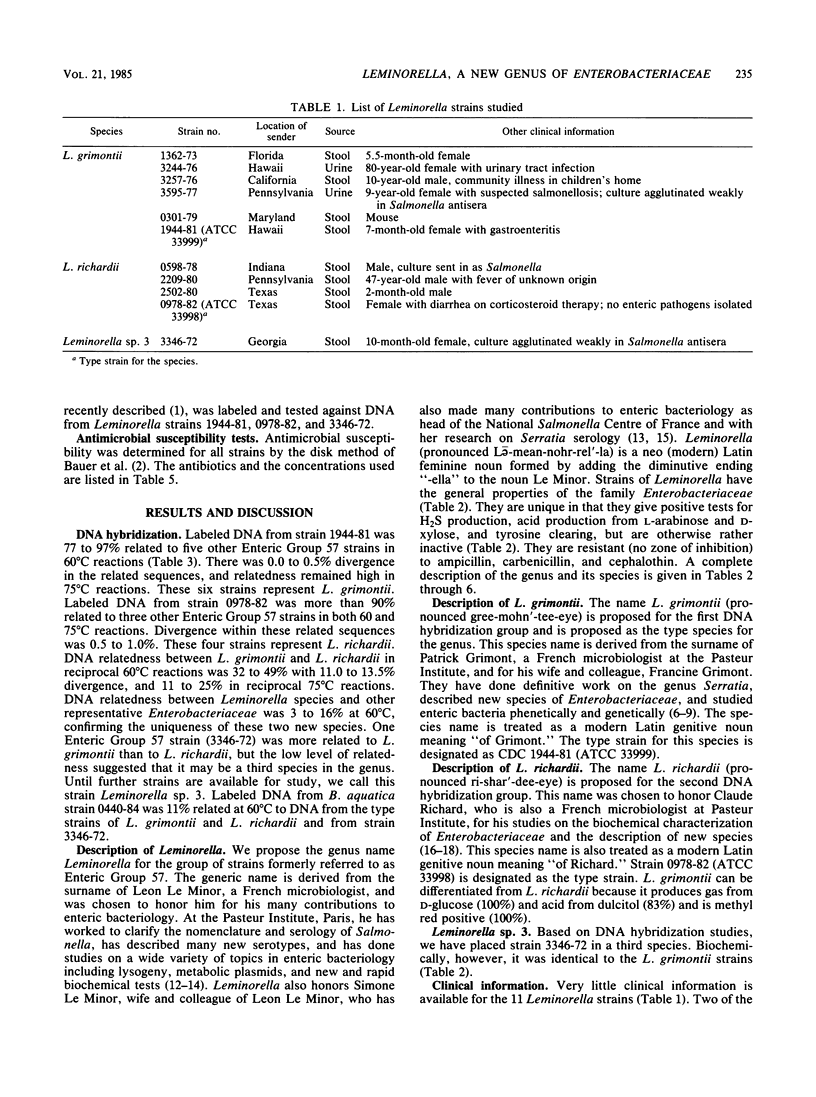
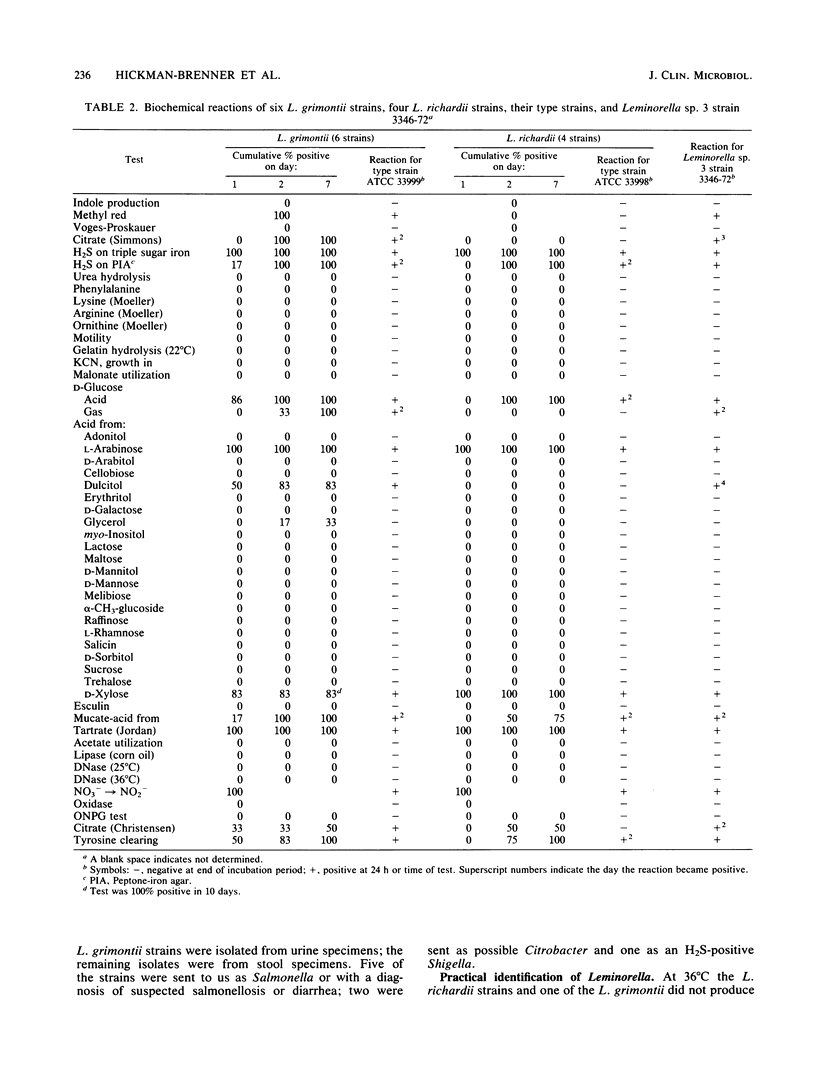
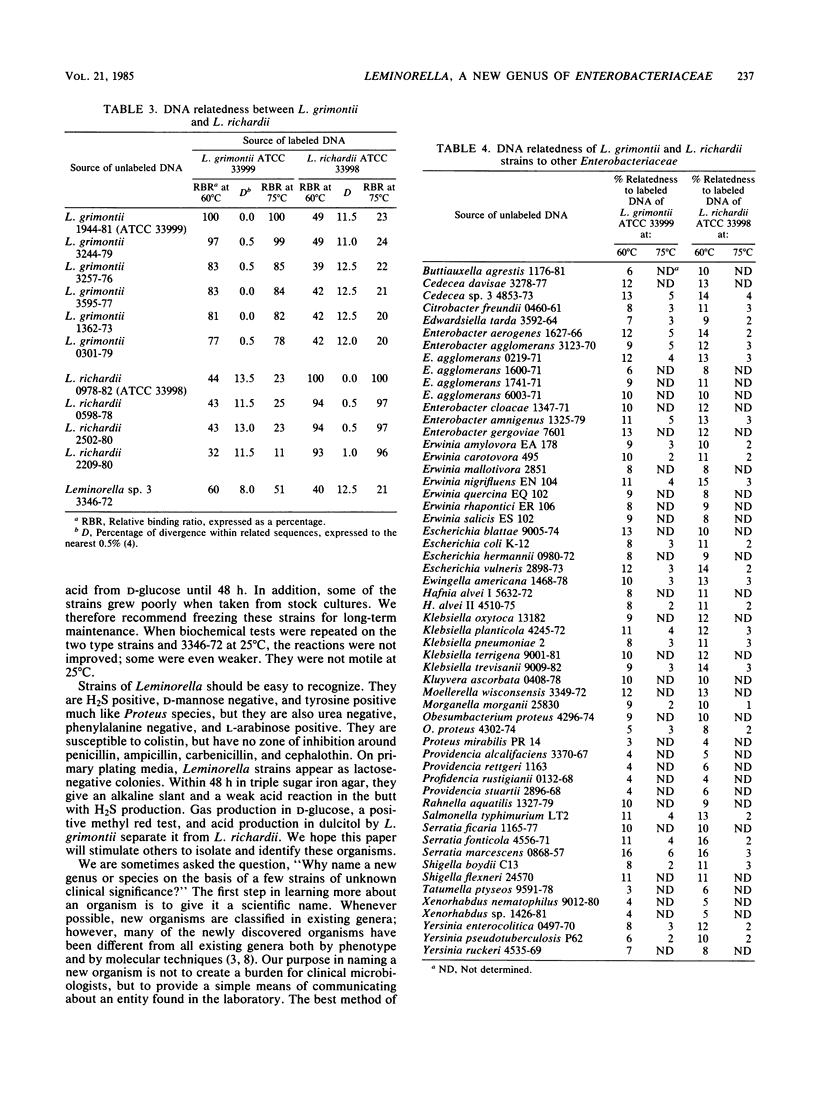
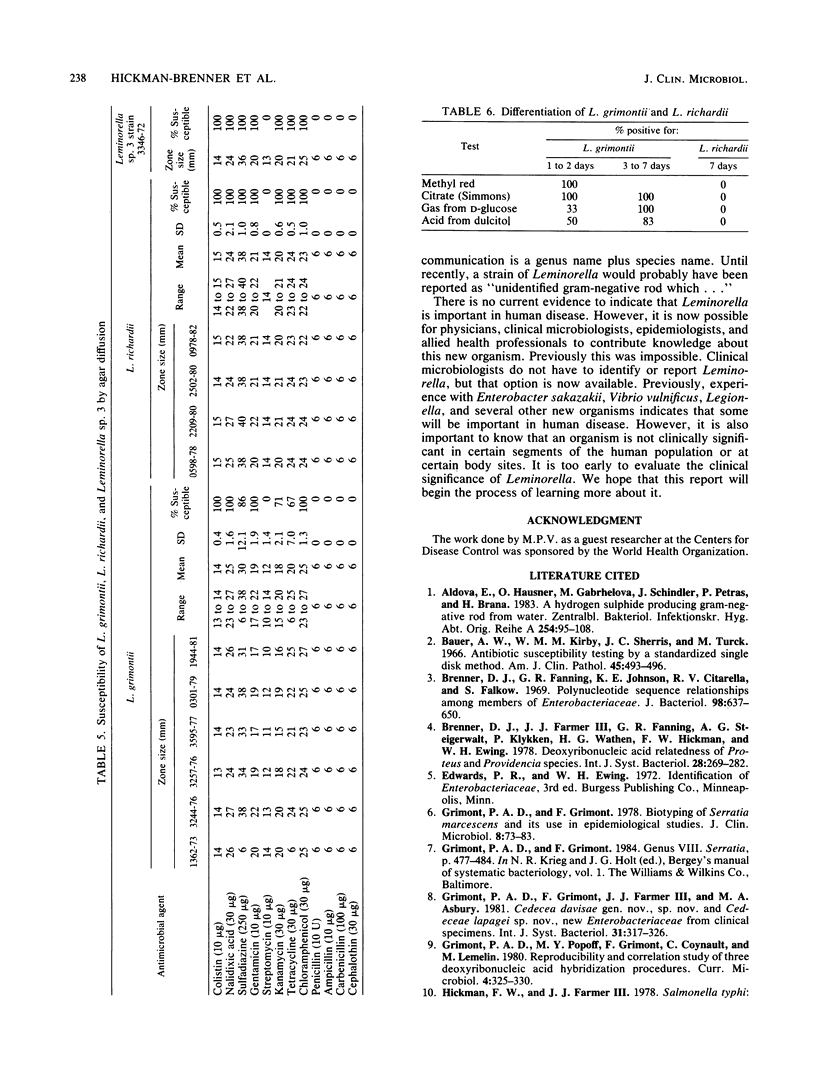
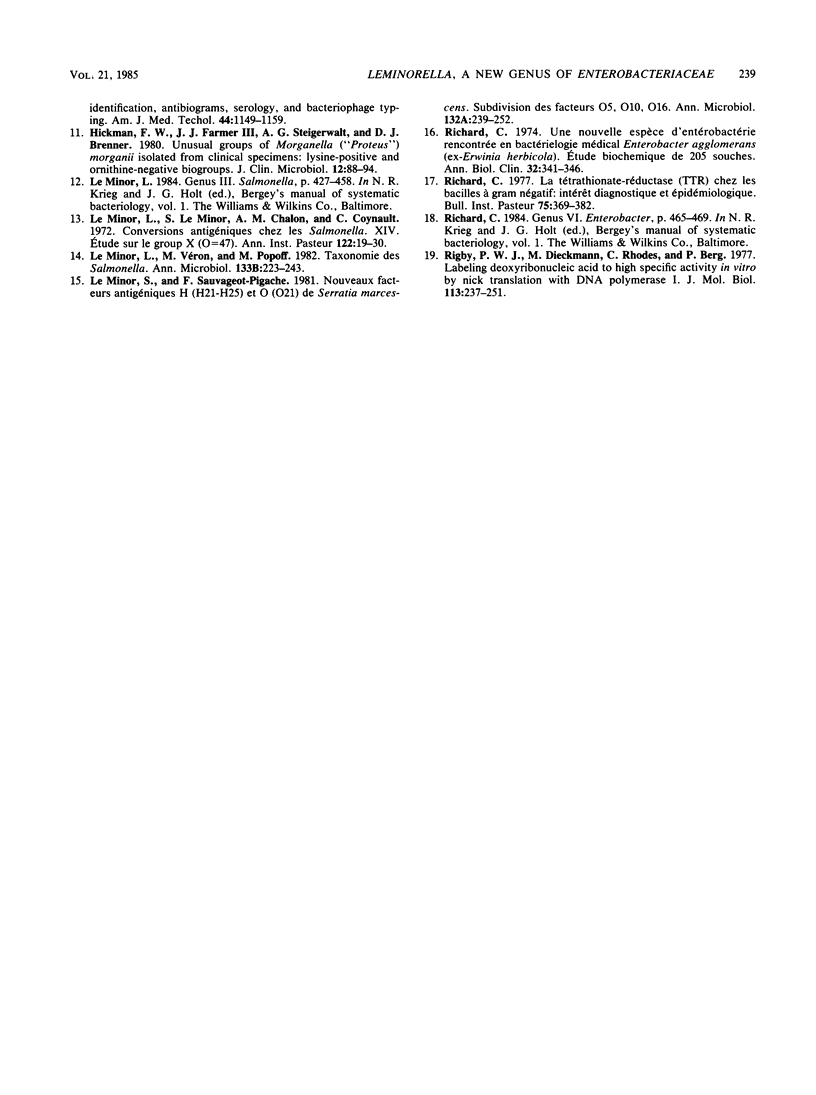
Selected References
These references are in PubMed. This may not be the complete list of references from this article.
- Aldová E., Hausner O., Gabrhelová M., Schindler J., Petrás P., Braná H. A hydrogen sulphide producing Gram-negative rod from water. Zentralbl Bakteriol Mikrobiol Hyg A. 1983 Mar;254(1):95–108. [PubMed] [Google Scholar]
- Bauer A. W., Kirby W. M., Sherris J. C., Turck M. Antibiotic susceptibility testing by a standardized single disk method. Am J Clin Pathol. 1966 Apr;45(4):493–496. [PubMed] [Google Scholar]
- Brenner D. J., Fanning G. R., Johnson K. E., Citarella R. V., Falkow S. Polynucleotide sequence relationships among members of Enterobacteriaceae. J Bacteriol. 1969 May;98(2):637–650. doi: 10.1128/jb.98.2.637-650.1969. [DOI] [PMC free article] [PubMed] [Google Scholar]
- Grimont P. A., Grimont F. Biotyping of Serratia marcescens and its use in epidemiological studies. J Clin Microbiol. 1978 Jul;8(1):73–83. doi: 10.1128/jcm.8.1.73-83.1978. [DOI] [PMC free article] [PubMed] [Google Scholar]
- Hickman F. W., Farmer J. J., 3rd Salmonella typhi: identification, antibiograms, serology, and bacteriophage typing. Am J Med Technol. 1978 Dec;44(12):1149–1159. [PubMed] [Google Scholar]
- Hickman F. W., Framer J. J., 3rd, Steigerwalt A. G., Brenner D. J. Unusual groups of Morganella ("Proteus") morganii isolated from clinical specimens: lysine-positive and ornithine-negative biogroups. J Clin Microbiol. 1980 Jul;12(1):88–94. doi: 10.1128/jcm.12.1.88-94.1980. [DOI] [PMC free article] [PubMed] [Google Scholar]
- Le Minor L., Véron M., Popoff M. Taxonomie des Salmonella. Ann Microbiol (Paris) 1982 Sep-Oct;133(2):223–243. [PubMed] [Google Scholar]
- Le Minor S., Le Minor L., Chalon A. M., Coynault C. Conversions antigénigues chez les "Salmonella". XIV. Etudes sur le groupe X (0:47. Ann Inst Pasteur (Paris) 1972 Jan;122(1):19–30. [PubMed] [Google Scholar]
- Le Minor S., Sauvageot-Pigache F. Nouveaux facteurs antigéniques H (H21-H25) et O (O21) de Serratia marcescens: subdivision des facteurs O5, O10, O16. Ann Microbiol (Paris) 1981 May-Jun;132(3):239–252. [PubMed] [Google Scholar]
- Richard C. Une nouvelle expèce d'entérobactérie recontrée en bactériologie médicale: Enterobacter agglomerans (ex-Erwinia herbicola). Etude biochimique de 205 souches. Ann Biol Clin (Paris) 1974;32(4):341–346. [PubMed] [Google Scholar]
- Rigby P. W., Dieckmann M., Rhodes C., Berg P. Labeling deoxyribonucleic acid to high specific activity in vitro by nick translation with DNA polymerase I. J Mol Biol. 1977 Jun 15;113(1):237–251. doi: 10.1016/0022-2836(77)90052-3. [DOI] [PubMed] [Google Scholar]


